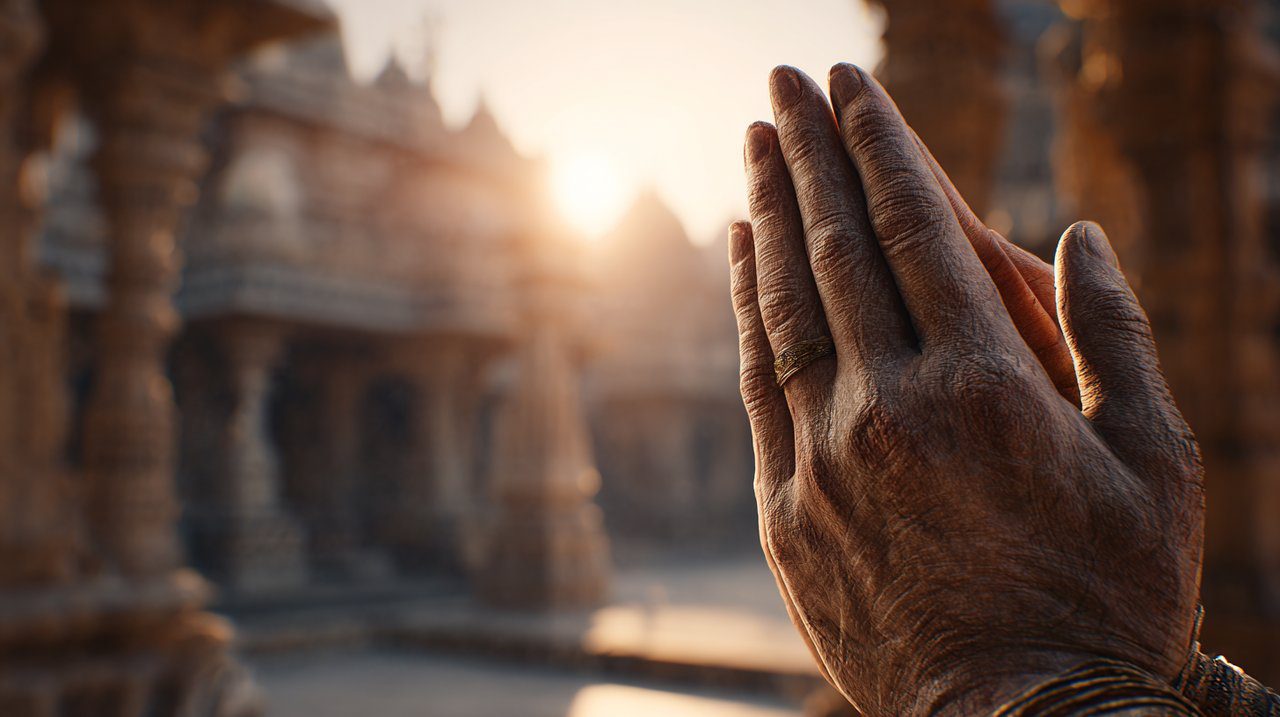Namaste: The Unspoken Bridge of Inner Light
Have you ever paused to consider the quiet understanding that exists between two ancient trees in a forest? Their roots, unseen beneath the soil, gently intertwine, and their branches sway together in a shared breeze. No words are spoken, yet a profound respect echoes through their very presence.
This silent acknowledgment, this deep, unspoken connection, beautifully mirrors the essence of Namaste. It is far more than a simple greeting; it is a bridge woven from reverence, connecting the inner light within one being to the inner light within another.
The Namaste Sign: A Whisper from Ancient Earth
Before our world became a landscape of bustling rush and clamoring modern talk, humanity often sought deeper ways to honor the sacred. Namaste emerges from this ancient seeking, much like a spring bubbling forth from hidden depths.
Its roots stretch back into the Vedic traditions, from a time when life itself was intimately woven with spiritual practice. This seemingly simple gesture carries the quiet weight of millennia, a silent witness to countless dawns and dusks, and a gentle reminder of our shared humanity.

Tracing the Roots: From Sacred Texts to Daily Life
If we trace its origins, the earliest mentions of Namaste appear within ancient Indian scriptures and texts. Here, it was not merely a polite salutation, but an act deeply imbued with a spiritual significance that acknowledged the divine presence in all beings.
From these sacred beginnings, the practice gently flowed into the rhythm of daily interactions. It became a profound way for people to greet elders, teachers, and guests, conveying a deep respect that transcended mere spoken words.
The Sound of Reverence: Deconstructing the Word ‘Namaste’
The very word "Namaste" is like a quiet poem, whispering its meaning. It comes from Sanskrit words: "Namah," which means "bow," "obeisance," or "adoration," and "te," meaning "to you."
So, its literal translation is "I bow to you." Yet, like the surface of a deep pond only hinting at what lies beneath, its spiritual depth extends far beyond this simple phrase. It is a humble acknowledgment of the spirit that resides within.
Beyond the Bow: Unveiling Namaste’s Spiritual Heart
The true power of Namaste resides not in the outward gesture, but in the quiet intention it holds. It is a recognition of shared divinity, a silent affirmation of our profound interconnectedness.
Consider a single raindrop, returning to the vast ocean; each individual, similarly, carries a piece of the universal spirit. This deep understanding allows us to move beyond superficial differences, inviting a moment of pause, a breath of quiet acknowledgment in every encounter.
The Divinity Within: Acknowledging the Inner Light
At its very core, Namaste whispers, "The divine light within me bows to the divine light within you." It suggests that within each person, much like the hidden core of a seed, resides a spark of the sacred—a pure essence untouched by the world’s passing shadows.
When we offer Namaste, we are honoring this inherent goodness. It is an act of seeing past the transient forms to the eternal spirit, cultivating inner peace not just for ourselves, but extending that serenity to the one we greet.

A Bridge to Unity: Connecting Selves and Souls
Namaste acts as an invisible bridge, connecting individuals not merely on a social level, but on a deeper spiritual plane. This gesture gently fosters a sense of unity, reminding us of our shared journey and common origin.
It is like a silent prayer for harmony, a recognition that in every encounter, there exists an opportunity for profound connection and mutual respect. This quiet reverence helps foster consciousness expansion, much like a forest ecosystem thrives through the interconnectedness of all its parts.
The Gentle Practice: Mastering the Namaste Gesture
To offer Namaste is to engage in a truly mindful act. It is not about adhering to rigid rules, but about cultivating a genuine presence within.
The gesture itself becomes a physical manifestation of an inner state. Much like a river flowing smoothly around stones, the practice should feel natural and unforced, yet always carry a clear, gentle intent.
The Hand Mudra: Posture and Presence
The common gesture involves pressing the palms together, usually at the heart chakra, with thumbs resting gently against the sternum. The fingers point upwards, a subtle symbol of aspiration.
This hand position, known as Anjali Mudra, is often seen in Yoga poses. It gently helps to center the mind and bring focus to the heart space, naturally enhancing the sincerity of the greeting.

When and How: Contexts of Respectful Exchange
Namaste can be offered at the beginning or end of a meeting, a yoga class, or indeed, any interaction where feelings of respect and gratitude naturally arise. The key, always, is intention.
Whether expressed through spoken word or in silent gesture, the offering should spring from a place of genuine reverence. It is a quiet acknowledgment of the other’s presence and the spirit they carry.
Namaste in Modern Flow: Cultivating Presence and Peace
In our hurried, modern world, moments of genuine connection can often feel rare, like finding a quiet clearing in a bustling forest. Namaste offers a simple yet profoundly powerful way to reclaim these precious moments.
It is a natural pause, a deep breath, a gentle reminder to truly see one another. This practice extends far beyond formal settings, becoming a way to navigate the currents of daily life with quiet grace.
A Daily Reminder: Embracing Inner Harmony
Integrating the spirit of Namaste into our daily lives means cultivating a continuous awareness of the inner light in all beings. It is a practice of seeing the sacred woven into the fabric of the mundane.
This mindful approach gently helps to foster personal inner peace, much like still water reflects the sky, reducing friction and promoting deeper understanding in every interaction.
Beyond the Mat: Extending the Gesture’s Spirit
The spirit of Namaste can effortlessly transcend the physical gesture. It can manifest as a silent acknowledgment in a crowded street, or a fleeting moment of empathy shared with a stranger.
It gently invites us to carry an open heart, offering respect and recognizing the shared human journey. Consider the quiet harmony found in a thriving forest ecosystem; Namaste encourages a similar interconnectedness in our human world.
In its quiet grace, Namaste reminds us that beneath the surface of words and actions, a profound connection patiently awaits. It is a simple gesture, yet it carries the deep wisdom of ancient earth, guiding us to acknowledge the divine spark within every being.
Just as a gentle stream finds its path around obstacles, may we find our way to deeper understanding through such mindful practices. Consider for a moment how a simple pause, a moment of genuine reverence, can transform your daily encounters.
To deepen this journey, exploring practices that cultivate presence and connection, perhaps mindful meditation or reflective journaling, can further open the heart to the quiet wisdom that Namaste embodies.
💡 Häufig gestellte Fragen
'Namaste' literally translates from Sanskrit as 'I bow to you,' derived from 'Namah' (bow, obeisance) and 'te' (to you). Spiritually, it signifies a profound recognition and honor of the divine light or spirit within another person, essentially meaning 'The divine light within me bows to the divine light within you.'
The practice of Namaste originates from ancient Indian Vedic traditions and is mentioned in ancient scriptures. Initially, it was a gesture deeply imbued with spiritual significance, acknowledging the divine in all beings. Over time, it flowed into daily life as a profound way to greet elders, teachers, and guests, conveying deep respect.
The common physical gesture for Namaste involves pressing the palms together, usually at the heart chakra, with thumbs gently resting against the sternum and fingers pointing upwards. This position, known as Anjali Mudra, is often seen in Yoga and is believed to help center the mind and bring focus to the heart space, enhancing sincerity.
The spirit of Namaste can be integrated into modern life by cultivating a continuous awareness of the inner light in all beings, seeing the sacred in the mundane, and carrying an open heart. It can manifest as a silent acknowledgment, a moment of empathy, or a gentle reminder to truly see one another, fostering presence and peace in everyday interactions.








